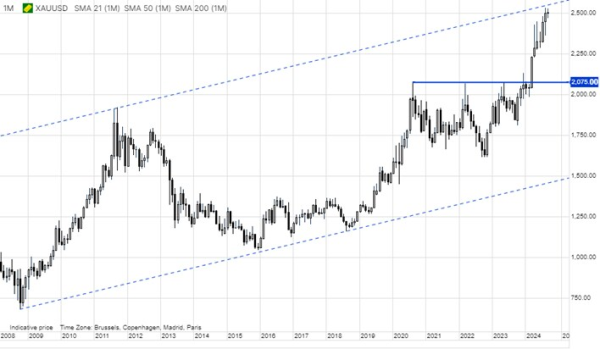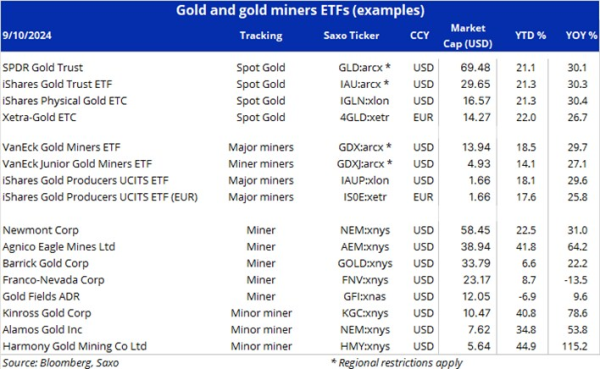US Election: will gold win in all scenarios?
Key points
- Gold's recent strong performance, with a 20% rise year-to-date and a high of USD 2,531.75 in August, has been driven by a combination of factors that have made it an attractive investment
- Supported among others by the uncertainty surrounding the upcoming US presidential election, which brings intense unease on the course of fiscal policy and overall market stability
- The combination of geopolitical risks, fiscal concerns, and potential shifts in monetary policy, particularly in the wake of the US presidential election, makes a bullish case for gold as a hard asset
Gold's recent strong performance, with a 20% rise year-to-date and a high of USD 2,531.75 in August, has been driven by a combination of factors that have made it an attractive investment. There are several reasons that the post-election environment could continue to support the gold price, which has handily outperformed the S&P 500 index and Nasdaq 100 index through early September of this year. As of 10 September, gold is up over 21%, while the S&P 500 index is up just shy of 15% and the Nasdaq 100 12.5%.
Here are some of the reasons, both pre- and post-election that gold has risen and could continue to perform strongly over the coming foreseeable time frame out to a year or more.
Fiscal profligacy. the uncertainty surrounding the upcoming US presidential election, which brings intense unease on the course of fiscal policy and overall market stability. First Trump and then Biden threw caution to the wind in blowing up the federal deficits in good times and especially bad (the pandemic response), with the US debt ripping above 120% of GDP. It doesn’t appear either party is set to deliver on fiscal austerity, which raises inflation risks, a gold positive. Trump wants to cut taxes with no credible plans for reducing spending, while Harris offers some new tax policy ideas and would like extend Biden’s huge fiscal programmes. Either administration would inevitably expand the deficit in an economic slowdown. And even if we have a president Harris or Trump with a divided Congress, meaning political gridlock, it means point 3 below – the Fed – has to work that much harder by easing policy.
General safe haven appeal. Gold has long been a safe haven in times of trouble and we could be nearing the end of an incredible run for stocks if we are headed toward a recession, something the bond market and its recent “dis-inversion” seems to be telling us. A dis-inversion happens when short term yields fall below long term yields, as the market expects the Fed to cut rates.
Fed rate cuts. As noted above, whether we are heading toward a slight slowdown or a full-blown recession, the US Federal Reserve’s monetary policy decisions will play a significant role in shaping gold’s trajectory. A rate-cutting cycle will begin this month at the Fed’s 18 September FOMC meeting, and a lower interest rate environment would likely boost gold’s appeal, especially if the Fed ends up cutting more than expected in coming months. Lower rates reduce the opportunity cost of holding non-yielding assets like gold, making it more attractive to investors. Historically, gold has performed well during periods of falling interest rates.
Geopolitics and “de-dollarization”. Furthermore, the broader global environment—characterized by geopolitical tensions, de-dollarization efforts by central banks, and economic uncertainty—continues to underpin demand for gold. In particular, central bank purchases of gold and strong retail demand in key markets like China have helped sustain the shiny metal’s rise, as investors seek stability amid volatile economic conditions. There may be more of an angle here if Trump wins and he delivers on his huge tariff threats as a widening group of countries look to transact outside the US dollar system.
Overall, the combination of geopolitical risks, fiscal concerns, and potential shifts in monetary policy, particularly in the wake of the US presidential election, makes a bullish case for gold as a hard asset. Note the implications of the phrase “hard asset” gold should always be seen mostly as something that preserves its value than as something that will go significantly higher in real terms (beyond the rate of inflation). Investors are likely to continue viewing gold as a hedge against the uncertainties posed by both economic and policy forces.
Over the past decade, gold has provided an average annual return of 8.4% in U.S. dollars, consistently outpacing inflation. This makes it an attractive option for long-term investors seeking to preserve purchasing power.

How to invest or actively trade gold?
Physical gold: Purchasing physical gold in the form of jewellery, coins, or bars provides direct exposure to the metal but involves considerations such as secure storage, insurance, and higher trading costs.
Gold ETFs/ETCs: Exchange-traded funds or commodities offer a convenient way to invest in gold without holding physical metal. These products track gold prices closely and can be traded easily on exchanges.
Gold mining stocks/ETFs: Investing in gold mining companies or ETFs that hold a basket of mining stocks provides exposure to gold prices. However, these investments carry operational risks and may exhibit higher volatility compared to gold itself. In recent years, the combination of inflation and interest rate hikes to combat has left some gold miners have struggling relative to the price of gold amid rising costs towards financing, labour, and materials.
Spot gold trading: A leveraged product that may suit traders using risk management tools while long-term investors may find ETFs being the better option. At Saxo you can use leverage to trade on the price of gold against 12 different currencies – including US dollar, euro, yuan and Swiss Franc – and silver.
Before proceeding you need to consider your tolerance for risk, and time horizon, as well as your personal financial goals. Gold is considered a relatively safe precious metal to invest in, but the price still responds to changes in other markets such as the dollar and government bond yields.
When to enter a trade or investment is always a challenge, whether it’s a stock or a commodity like gold. With that in mind a staggered approach may be the best suitable way to enter into a new position, i.e.. split the purchase into smaller portions spread over a predetermined time frame.

Recent commodity articles:
9 Sept 2024: COT: Crude long cut to 12-year low; Dollar short more than doubling
5 Sept 2024: Can gold overcome the 'September curse'?
4 Sept 2024: Wheat rises on European crop worries
3 Sept 2024: Chinese economic woes drag down crude oil and copper
2 Sept 2024: COT: Commodities see broad demand as the USD slumps to a net short
30 Aug 2024: Commodities sector eyes fourth weekly gain amid softer dollar and Fed expectations
27 Aug 2024: Month-long sugar slide pauses amid concerns of Brazil's supply
27 Aug 2024: Libya supply disruptions propel crude prices higher
26 Aug 2024: COT: Funds boost metals investment as dollar long positions halve amid weakness
23 Aug 2024: Commodities Weekly: Metal strength counterbalancing energy and grains
22 Aug 2024: Persistent supply contraints keep cocoa prices elevated
21 Aug 2024: Weak demand focus steers crude towards key support
19 Aug 2024: Resilient gold bulls drive price to fresh record above USD 2500
19 Aug 2024: COT Buyers return to crude as gold stays strong; Historic yen buying
16 Aug 2024: Commodities weekly: Gold strong as China weakness drags on other markets
9 Aug 2024: Commodities weekly: Calm returns to markets, including raw materials
8 Aug 2024: Sentiment-driven crude sell-off eases, allowing traders to focus on supply risks
7 Aug 2024: Limited short-selling interest observed during copper's recent aggressive correction
6 Aug 2024: Video: What factors are fueling the current market turmoil and gold's response
5 Aug 2024: COT: Broad commodities sell-off gains momentum; Forex traders seek JPY and CHF
5 Aug 2024: Commodities: Position reduction in focus as volatility spikes
2 Aug 2024: Widespread commodities decline in July, with gold as the notable exception